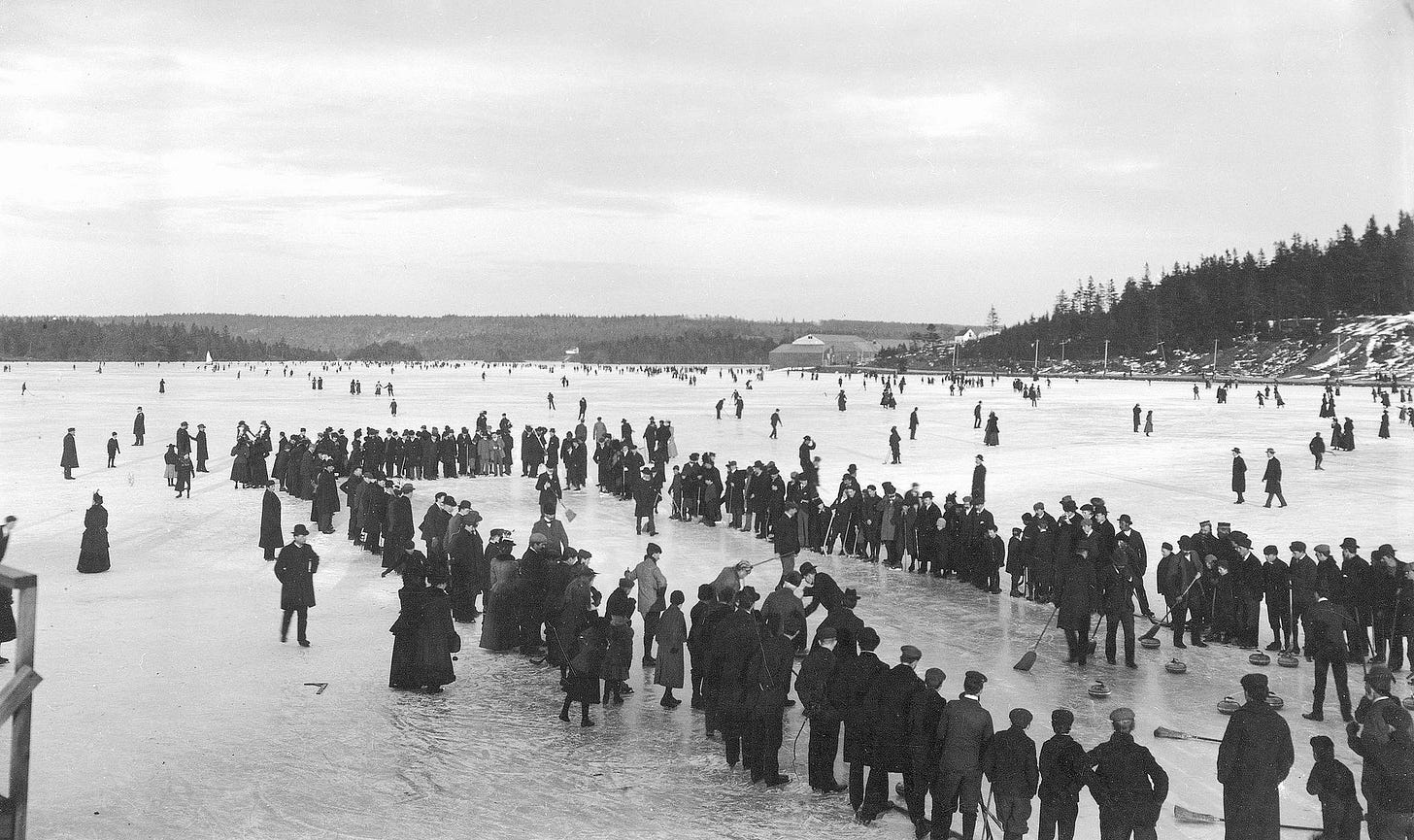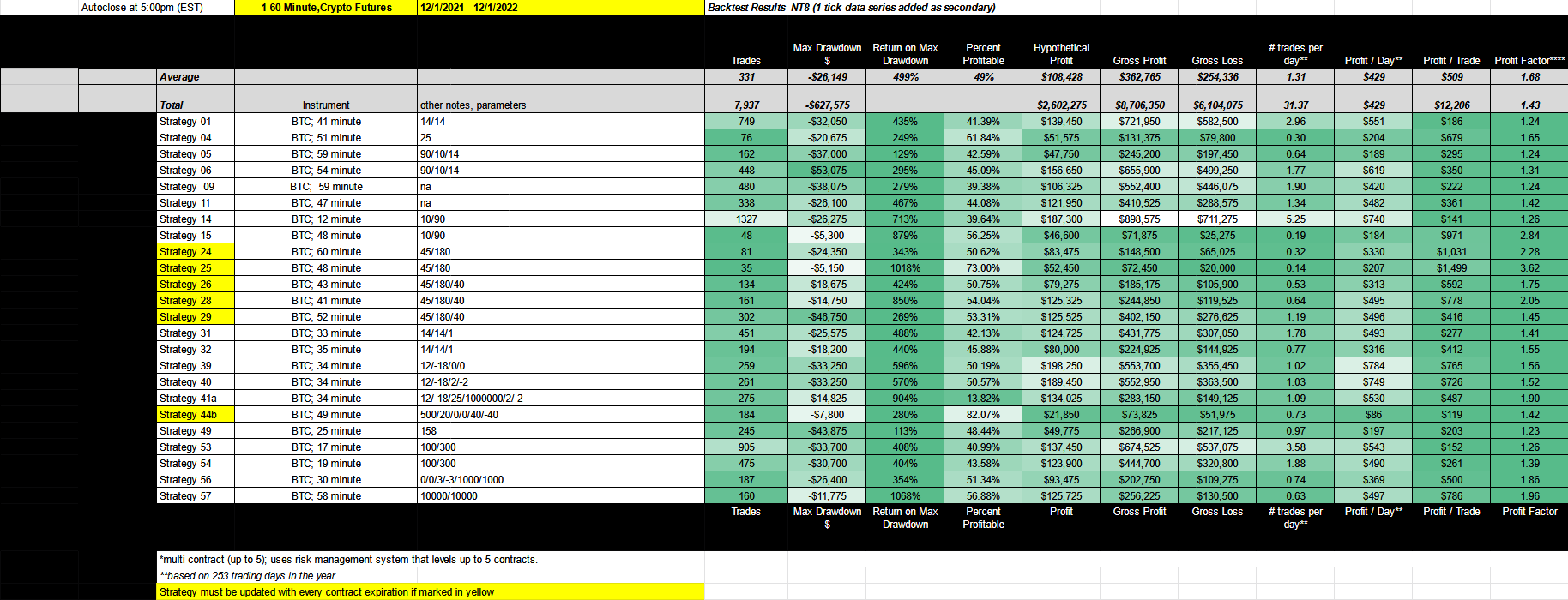Automated Trading Strategies: January 2023 Portfolio Update
Equity Futures update. Ag, Metals and BTC Futures added. We're ahead of schedule on the live test--Passed the initial funding evaluation and secured 3 funded prop accounts.
In case you didn’t know, we’re on the hunt for the holy grail of automated trade strategy. We define the holy grail of trade strategy as having the following attributes:
Profit factor (gross profit/gross loss) greater than 3
Annual max drawdown less than 3%
Annual return greater than 500%
Maximum daily low of -$1,000
Avg Daily profit greater than $1,000
Less than 5,000 trades annually
Greater than 253 trades annually
Every few months I like to look at how our top automated trading strategies are performing and update you on key findings, highlights, takeaways and what’s in the pipeline. I’ll be transitioning to quarterly updates going forward. This is the January 2023 update.
Important: There is no guarantee that our strategies will have the same performance in the future. We use backtests to compare historical strategy performance. Backtests are based on historical data, not real-time data so the results we share are hypothetical, not real. There are no guarantees that this performance will continue in the future. Trading futures is extremely risky. If you trade futures live, be prepared to lose your entire account. We recommend using our strategies in simulated trading until you/we find the holy grail of trade strategy.
Year In Review: Portfolio In Transition
We’ve been sliding around on the ice in a state of transition for the greater part of 2022. Today, like the granite stones in a curling game, we’re lining our best strategies up for review. At the end of the review I’ll show you the strategy we decided to ‘push out’ for a live test.
The goal of this review is to update you on any progress made since the last update. You can view past updates below:
How Far We’ve Come
When we first started (two years ago) we published 10 strategies that barely had a profit factor (gross profit/gross loss) greater than 1.05. Today, we have 60+ strategies with a minimum profit factor of 1.20.
When we first started, we used one instrument (NQ) and one data series (36 range). Today, we use over 30 instruments that are run on charts ranging from 1 to 60 minutes.
When we first started, we would have been blown away with a profit factor of 3.0. Today, we know that a profit factor of 3.0 is just the beginning. Indeed, over 15 of our strategy variations on the Equity Futures performance chart alone have a profit factor over 3.0.
When we first started, in a kind of mental masturbation, we optimized everything; today, after being impaled by a few over-fitted unicorns, we only optimize the time series.
When we first started, we thought the simulation had no limitations. Today, we know that using the simulation as a tool to find viable strategies must carry with it an understanding that accuracy holds an inverse relationship with complexity.
At the beginning of 2022, we decided to run several strategies live and they failed. They didn’t fail due to alpha decay, they failed because the backtest was inaccurate. The goal of our hunt necessitated a course correct.
So What Did We Do?
What could we do? We had to pull back and regroup. It was a humbling endeavor.
After much discussion we decided to lean into the limitations of the simulation. All strategies were transitioned to a minute-based data series--range and Renko are complex bar formations so the simulation has a hard time recreating it for the backtest. Switching to minute-based data doesn’t improve the simulation, but it improves backtest accuracy by giving the simulation an easier calculation to handle. We also diversified contracts--using more than one futures contract increases profitability and decreases risk without any associated cost. It also allows us to expand the hunt to the highest performing instruments.
Over the last two years, we’ve also learned that we’re looking for a strategy that most likely:
closes at the end of every day
has a data series from 1 to 60 minutes
uses a long stop loss as insurance, but relies on a change in market structure or support/resistance to exit a trade
uses a risk management system to leverage higher probability trades without the risk
uses a mixture of highly profitable strategies within a portfolio (high profit factor and/or high profit factor and % profitable), with one of those strategies possibly serving as a hedge to the others
has a trade count higher than 20 if part of a portfolio and 253 if standalone
Put together, we’re looking for a strategy that breaks the normal relationships/trade-offs found in performance metrics for automated trading strategies. For example:
instead of high profit factor, low trade count (what we usually see); we’re looking for high profit factor, high trade count.
instead of a low percentage of profitable trades and a high win/loss ratio (what we usually see); we’re looking for high percent profitable trades and a high win/loss ratio
instead of a high drawdown and high net profit (what we usually see), we’re looking for a low drawdown with a high net profit.
Now that we’ve figured out the best way to run a real-time test, the process for set up should be more transparent and provide better reporting in Q1 of 2023.
January 2023 Performance Chart
“The market is abundant”
- Anne-Marie Baiynd, Author of The Trading Book
The hunt is the same, but we’ve discovered a better path. In practical terms this means that we’re optimizing all strategies by data series and contract type to find the “best” performance. So, we’ve created four master strategy lists to align the best instrument and data series with the best strategy. The first list is based on equity futures:
Equity Futures: Master Equity Futures Performance Chart
E-mini Nasdaq-100 (NQ)
E-mini DOW (YM)
E-mini Russell 2000 (RTY)
E-mini S&P MidCap 400 (EMD)
E-mini S&P 500 (ES)
The following performance chart has been updated with backtests starting on 12/01/2021 and ending 12/01/2022 (these are all hypothetical results based on backtests not real-time data):

There’s a lot of information on this chart so let’s take a moment to digest what it’s telling you:
In the first column you’ll find the strategy number. Click here for a list with links to all strategy descriptions.
In the second column, you’ll find a list of the instrument and chart to use in order to obtain the results on the performance chart.
In the third column, you’ll find a set of additional parameters to use with the strategy.
The fourth column is the number of trades.
The fifth and sixth columns are the max drawdown and return on max drawdown for the strategy. The max drawdown is the most the strategy has ever fallen from its net profit high and return on max drawdown is a return metric that uses max drawdown as the required investment.
The seventh column is percentage of profitable trades.
The eighth column is net profit, which is composed of the ninth and tenth columns.
Columns eleven, twelve and thirteen are trade metrics that can be used to compare performance at the trade level; and finally,
Column fourteen is profit factor. This is a our primary measure of performance, though it cannot be used in a vacuum.
It is important to note that strategies are not optimized on indicator hyper-parameters, as that leads to overfitting, but on chart type. In particular, a 1 to 60 minute chart. You’ll notice that Strategy 1, one of the strategies we’re giving away for free, made the list.
We also did this for agricultural, metal, and BTC futures. What follows are the best strategy variations we found for each of these asset classes:
Agricultural Futures: Master Agricultural Futures Performance Chart
The following chart includes:
Cotton futures (CT)
Coffee futures (KC)
Soybean futures (ZS)
Rough Rice futures (ZR)
Wheat futures (ZW)
Soybean Meal futures (ZM)
Clearly, KC and CT dominate in ag futures.
Metal Futures: Master Metal Futures Performance Chart
The following chart includes:
E-mini Gold futures (QO)
Gold futures (GC)
Silver futures (SI)
Copper futures (HG)
On average, metals have a lower average net income, but we’ve got trade counts over 100 across the board, which increases the quality of results. Average drawdown is also below $10K.
BTC Futures: Master BTC Futures Performance Chart
The chart below provides an overview of our best performing strategies for Bitcoin futures (BTC).
You’ll notice that these strategies have a much higher average net profit at $108K, but they also have a higher average max drawdown at $26K. Both are due to a higher volatility in BTC than other instruments. As a general rule within the physics of trading, higher volatility tends to create higher net profit and drawdown. The key to finding the holy grail of automated trading strategies is in our/your ability to unlock this relationship — we’re looking for a way to get from A to B by folding the plane.
In April, we’ll come back to compare these portfolios. Look for energy, FX and interest rate futures in the coming month.
Portfolio Theories
In addition to single strategies, we’ve also been tracking several portfolios in real-time. Each portfolio was based on a different portfolio theory. Over the first 12 weeks, only three of the nine portfolios were profitable (54a, 54b and 55b). In that process, we made some interesting discoveries:
there are many ways to construct a portfolio: by profit factor, percentage of profitable trades, net profit, drawdown percentage, etc.
portfolio strategies with a low percentage of profitable trades are prone to backtest error because it only takes one missed profitable trade to throw the strategy off.
portfolio strategies with a higher percentage of profitable trades (greater than 70%) and a higher net profit perform better than strategies chosen based on the highest profit factor alone.
portfolio strategies with a higher percentage of profitable trades and a higher net profit perform better than strategies with the lowest drawdown.
Boiled down, we’re talking about strategies that have the:
‘highest net profit’ and
‘highest % of profitable trades’.
If we use the same logic to select strategies for the upcoming quarter, these are the strategies with the highest net profit from 12/01/2021 to 12/01/2022:
You’ll also notice a high number of trades and a high average drawdown. In general, Strategies 6 and 53 look the most intriguing from a trade count perspective.
These are the strategies that were profitable over 70% of the time:
You’ll notice a lower trade count, lower average drawdown, and lower net profit.
We’ll be adding these portfolios to the real-time test. Results will be published in the Mudder Report.
Where Are We In The Hunt?

Over the last three months ATS has published: Strategy 54, 55, 56, 57, 58, and 59.
We also published How To Update A Strategy To The Current Front Month In NT8 Using The Strategy Builder and How To Set Up & Manage Automated Trading Strategies On A Virtual Server With NT8.
We selected a simple portfolio analyzer that works with NT8. The tool is easy to use and gives some insight into the actual drawdown you might have if you run two strategies at the same time (Portfolio Architect by TradingIndicators). This is not a capability within the NT8 Strategy Analyzer. I’m still researching a portfolio analyzer with the capability to optimize strategies and run correlation studies within a portfolio. I think this will do to our hunt what infrared did to the search for the discovery of new planetary bodies, but it’s also the kind of thing that requires a great deal of research on the front-end. One example of what it will allow us to do is group low-trade, high-profit factor strategies with 0 correlation together.
We applied for several funding accounts and secured three. Note: I can’t attribute our performance in the evaluation accounts to any one strategy, but Strategy 56 and 58 were both used in some way. We are currently testing several variations of Strategy 56 on all three prop accounts.
I’ve recently started several threads on Substack Chat dedicated to strategy development, python translation, funded accounts and general announcements. The threads are a great way to reach out to others on the hunt.
Most traders aren’t testing their own backtests and if they are, they certainly aren’t foolish enough to share the results. But it has always been the plan to use this research to conduct our own live test, so playing the fool is the least of my concerns.
We started out thinking that we’d found the holy grail in Strategy 10, but got impaled instead. The betrayal of Strategy 10 led to an all out investigation, which culminated in the master lists provided above and the Mudder Report. The Mudder Report is a weekly report that tracks certain strategies in real-time. Results from the report were mixed, but exposed several strategies that we decided to test in real-time using a funded trader program.
By the middle of December, we had secured three funded accounts from Apex Funding (we have no affiliation with Apex) so we’ve started the semi-live hunt sooner than planned. We are currently in the process of testing several strategies in these accounts. It is important to note that I can’t attribute passing the evaluation to any one Strategy, and I don’t recommend our strategies for anyone that’s trying to pass a funding evaluation.
Apex is relatively new on the funding scene (there are many others) so I’m going to wait until after we receive the first $25K withdrawal to give a full review, but so far so good. The website boasts the following stats:
Meanwhile, this funding model offers a nice middle ground between the simulation and live testing using our own capital. Results from these live tests will be shared with paid subscribers in the Mudder Report and Substack Chat.
What have we learned from running live strategies: make your best push and then let go
When we first started this, I thought running a strategy would feel a bit like this — such focus, certainty:
But now that we’ve actually started a semi-live test, I feel more like this:
With the exception of a few administrative options, there’s just so much I can do — I can’t touch the thing, but I want to. I had no idea it would be so hard to let go.
So, what can I tell you about my experience with switching from a manual to semi-automated strategy?
Before a curler pushes out from the hack to deliver a stone they must know: 1) where they want to send the stone, 2) where to aim in order to get the stone to that location, 3) the right rotation to place on the handle to curl the stone; and, 4) the amount of pressure or speed you need to push out of the hack. Running strategies is the same way and I talk about what’s required to set up and manage strategies in the post: How To Set Up & Manage Automated Trading Strategies On A Virtual Server With NT8, which is a living document. You’ll want to know 1) what to expect from the strategy on any given day, 2) the best day and time to start the strategy, 3) the best data series to run the strategy on; and, 4) the optimal number of contracts you want to trade. After that, with the exception of big economic releases, you have to trust the strategy.
In Strategy 58, I attempted once more to automate my own manual strategy and failed again. It is as close as I’ve gotten, but still lacks the nuance that comes with years of trading. What we lack as humans is the ability to act without emotion; what the simulation lacks is the ability to mimic the complexity of the human brain, especially when it comes to pattern recognition.
So the best way to use automated trading strategies is as a guide to merge worlds. In other words, automated strategies work best to help manage emotion, not check out. We provide a description of how to recreate the strategy and a download (C#) to make the process as easy as possible, but you still have to do the work. In other words, you’ll want to think of automated trading strategies like the corrective braces young Forest Gump wears below — no matter your skill level, they have the potential to help you develop your best “trading” self; your most disciplined self. The only thing you really have to do is make your best push and then let go.
When the time comes, you’ll be able to break free from the braces and the simulated environment altogether, which is exactly what we’re in the process of trying to do.
The Year Ahead: Inflation, Reflection, & The PCE, Oh My
“It will take substantially more evidence to give comfort that inflation is actually declining. By any standard, inflation remains much too high.”
Inflation and the Labor Market, Chair Jerome H. Powell
November 30, 2022
How could I wrap this up without a few words on inflation?
In the beginning of 2022 I wrote about volatility and its impact on automated trading strategies. In particular, it increases the likelihood that backtest results will be misleading. It also increases your drawdown and therefore the amount you need to maintain in your account at all times to withstand it. But, it also increases your potential for higher profitability.
Since it appears that the coming year will provide even more volatility than the last and that the fight between the banking industry (Powell) and business leaders is starting to heat up in historic fashion, we can approach the year with an eye toward taking advantage of the volatility and limiting our exposure to risk. In other words, I have every expectation that what worked in 2022 is going to work in 2023.
There’s also a slight expectation (on my part alone) for prices to continue to climb until the whole house of cards collapses, which could be 50 or 60 years from now. Personally, I’m looking to diversify by investing in countries that don’t invoice in dollars. But because most of the world’s imports are invoiced in dollars, the dollar and everyone that uses it, are largely insulated against the effects of 20 years of massive government and central bank spending. The impact will be growth in the form of higher and higher inflation. In other words, we are at the beginning of a dollar bubble. This also has some interesting implications on certain currency crosses, which is why we’ll be following FX futures this year.
So What
“The truth is that the path ahead for inflation remains highly uncertain.”
Inflation and the Labor Market, Chair Jerome H. Powell
November 30, 2022
And with uncertainty comes volatility. And with volatility comes opportunity.
Fed Chair Powell has turned the release of CPI\PCE data into “big days” for those on the hunt for price action. Other days to look out for are any Powell speech or public appearance. The Federal Reserve is under pressure from the entire business community, including former U.S. Treasury Secretary and Harvard President Larry (dimwit) Summers, to increase the inflation threshold and yet Powell has doubled down on his commitment to hold at 2% (bravo but it’s too late). Banks lose money with inflation, so Powell is passing that problem right along to the business community in the form of higher rates on debt. That puts the business community under increased pressure to reduce inflation and the only way they can do that is to perpetuate the bubble.
Either way, it’s only a matter of time before Powell makes the big announcement to increase the maximum inflation rate and when he does, the market will pop (for better or worse), and the scene that follows will look something like the sketch below on Wall Street.
I want us to be ready for that day.
Meanwhile, we’ll continue to:
develop and publish strategies (Strategies 60, 61, 62, 63 and 64), including our first hedged strategy as well as the use of two new indicators to help isolate price patterns:
Strategy 60 will be published on ATS on January 15
Strategy 15 will be published to ATS Mini on January 15
track the performance of certain strategies and portfolio theories in real-time with the Mudder Report and semi-live Apex prop accounts.
The next Mudder Report will be posted to ATS on January 8.
All subscribers of ATS and ATS Mini will receive two weeks added to your subscription starting today.
I’m often asked, ‘why are you doing this’? I started this as a way to journal and document our hunt, but I’ve stayed with it for very selfish reasons — I’ve learned so much from the process. My trading has improved greatly. It is more calculated and nuanced. It uses more tools, follows more rules and is more surgical. Most importantly, I have an increased awareness for what my strengths and weaknesses are. I’ve also met some truly fascinating people in the process. So, I want to take this time to say thank you, especially to all of our subscribers. I am truly grateful to be on this journey with you and I hope to see more of you in the Substack chat in 2023.
This is going to be our best year yet.
If you have any questions, comments or recommendations, please reach out by responding to this post or emailing at AutomatedTradingStrategies@protonmail.com.
Click here for strategy links.
Click here for FAQs.
Automated Trading Strategies is a reader-supported publication. To receive new posts and support this work, consider becoming a free or paid subscriber.
We have no affiliation with any vendor mentioned or linked to in this post.















